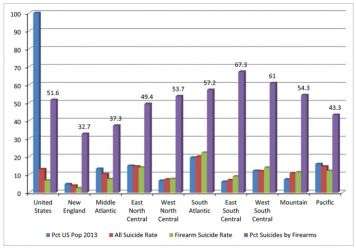New study links suicide with rates of gun ownership and how weapons are stored

If guns were less available, fewer people would succeed in killing themselves, even if many would seek alternative ways of trying, concludes Augustine Kposowa, sociology professor at the University of California, Riverside.
In his new study, "Impact of Firearm Availability and Gun Regulation on State Suicide Rates," published in the journal Suicide and Life-Threatening Behavior, Kposowa found that household gun ownership was strongly associated with both suicides by all methods, and by use of firearms. Weapon storage practices also had a significant impact on suicide rates.
"In general, the findings of the study are consistent with the proposition that household gun ownership and keeping guns in the home that are loaded, and especially loaded guns that are unlocked, are significant contributors to the U.S. suicide rates at the state level," explained Kposowa.
According to a 2014 report by the World Health Organization, 800,000 people around the world die of intentional self-harm annually. In the Unites States, the Centers for Disease Control and Prevention (CDC) reported that 40,600 people died by their own hands in 2012, this is a higher rate than any other advanced industrial nation. Guns were the cause of nearly 51 percent of U.S. suicide deaths from 2004 to 2012, never falling below 50 percent in any year (CDC, 2015).
In the study, Kposowa found that states with higher gun ownership rates have higher suicide rates. How the gun is stored appears to be even more consequential than if they are present in the home. If the gun is loaded, it adds to the risk – the increase in firearm suicide mortality nearly triples if a gun in the home is kept loaded (14 percent to 51). If it is loaded and unlocked, the risk of suicide increases again, to 76 percent.
"This finding is consistent with the observation that attempted suicide is most often an impulsive act whose outcome very much depends on immediate access to a lethal weapon. If firearms were less available in the U.S., fewer people would succeed in killing themselves, even if many sought substitute ways of trying," said Kposowa.
The study also found that:
- States with weaker handgun regulations tend to have higher suicide rates.
- Distribution of suicide has changed, slightly. It used to be believed that suicide rates were lowest in the Northeast and rose as you moved west. That is no longer true. For example, New England has the lowest suicide rates, but that region is then followed by the West, North Central U.S., and the East South Central region. If a direct East–West gradient in suicide once existed, it appears to have been lost, and we are left with a much more complicated pattern of suicide and firearm suicide distributions.
- Suicide rates jump dramatically when greater numbers of people are unemployed for extremely long periods of time.
- Divisional divorce rates have no significant influence on overall suicide rates, but it does appear to increase firearm suicides. Divorce is also strongly associated with loaded guns, gun readiness, and with weaker gun regulation, albeit modestly.
The sociologist said that although policies aimed at regulating firearm ownership would reduce individual suicides, such policies are likely to fail, not because they do not work, but because many Americans remain opposed to meaningful gun control.
"Even modest efforts to reform gun laws are typically met with vehement opposition. There are also millions of Americans who continue to believe that keeping a gun at home protects them against intruders, even though research shows that when a gun is used in the home, it is often against household members in the commission of homicides or suicides," Kposowa said.
He notes that at present, the U.S. lacks current data on gun ownership in the country, an outcome that severely limits the research community's ability to provide empirical information on which to base suicide prevention efforts.
"This rather odd situation represents the failure of federal policy that can be addressed only by Congress and the President. It can be relatively rectified by repealing any laws inhibiting the CDC from collecting individual and household gun ownership data," Kposowa explained.
More information: Augustine Kposowa et al. Impact of Firearm Availability and Gun Regulation on State Suicide Rates, Suicide and Life-Threatening Behavior (2016). DOI: 10.1111/sltb.12243
















